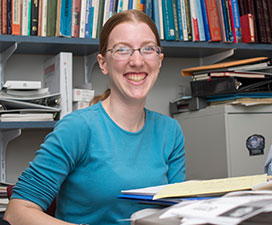Heather Callaway Awarded NSF Fellowship

First year Baker Institute student Heather Callaway has been awarded a prestigious National Science Foundation (NSF) Graduate Research Fellowship to continue her Ph.D. research on parvovirus in Dr. Colin Parrish’s lab. The competitive fellowship program is meant to “ensure the vitality of the human resource base of science and engineering in the United States,”
Heather was a little incredulous when she got the good news in an email from NSF.
“I couldn’t believe it. They sent out the notification on April Fools’ Day. I called my parents and they said, are you sure this it isn’t a prank or something?” she said. “It’s not something I was expecting.” The fellowship includes three years of stipend as well as an education allowance for tuition and fees.
NSF first awarded the fellowships in 1952. Today, they have funded over 46,500 fellowships from a total of more than 500,000 applicants. More than 30 fellows have gone on to earn a Nobel Prize, and over 440 have earned membership in the National Academy of Sciences.
For her graduate research, Callaway is focused on understanding mutations in canine parvovirus (parvo), a pathogen that emerged as a new virus disease among dogs in Europe during 1977 and then went on to cause a global pandemic during 1978. Baker Institute scientists first isolated the virus in 1978, and by late 1979 had developed the first vaccine to protect dogs against the virus. By 1981, Baker Institute scientists had created an improved attenuated vaccine for the disease. Dr. Parrish was instrumental in these discoveries, as well as for numerous other advances in parvovirus biology since that time.
The mutations Callaway is interested in have often resulted in a virus that is unable of infect dogs. “I’m trying to see how different mutations affect the parvovirus capsid (particle) structure, alter cell receptor and modify antibody binding. Also, I am examining the effects of several mutations that make the virus noninfectious,” says Callaway. “I’m trying to pin down the roles of those mutations to see what specific processes they interfere with.”


